模拟单链表
方法:两个数组,一个存该索引位置的 val , 另一个存该索引位置的下一位置(即下一个位置的索引是啥)。
其中,第0号位置仅表示 链表的 head,不进行使用。
#include <iostream>
using namespace std;
const int N = 1e5+10;
int val[N], nextA[N], len, head;
// 向第k个元素后插入一个节点x
void insert(int k,int x){
val[len] = x;
nextA[len] = nextA[k];
nextA[k] = len;
++len;
}
// 删除第k个节点
void delet(int k){
nextA[k] = nextA[ nextA[k] ];
}
// 遍历这个单链表
void traval(){
int cur = nextA[head];
while(cur != -1){
cout << val[cur] << ' ';
cur = nextA[cur];
}
}
int main(){
int n; cin >> n; cin.get();
// 对链表的初始化
head = 0; len = 1; nextA[head] = -1;
for(int i = 0; i < n; ++i){
char oper; int x, y;
oper = cin.get();
if(oper == 'H'){
cin >> x; cin.get();
insert(0,x);
}
else if(oper == 'I'){
cin>> x >> y; cin.get();
insert(x, y);
}
else{
cin >> x; cin.get();
delet(x);
}
}
traval();
}
模拟双向链表
思路同模拟单链表,只是这里需要两个数组来存指针,并且在删点、加点的操作上有些许区别。
双链表把数组的0位置作head,1e5+3位置 ( 其实可以随意 ) 作tail。
#include <iostream>
using namespace std;
const int N = 1e5 + 10;
int val[N], pre[N], nxt[N], len, head, tail;
void init(){
head = 0; tail = 1e5+3;
pre[head] = -1; nxt[head] = tail;
pre[tail] = head; nxt[tail] = -1;
len = 1;
}
void insert(int k, int v){
val[len] = v;
pre[len] = k;
nxt[len] = nxt[k];
pre[nxt[k]] = len;
nxt[k] = len;
++len;
}
void delet(int k){
nxt[pre[k]] = nxt[k];
pre[nxt[k]] = pre[k];
}
void traval(){
int cur = nxt[head];
while(cur != tail){
cout<<val[cur]<<' ';
cur = nxt[cur];
}
cout<<endl;
}
int main(){
int m; cin>>m;
string oper; int x, y;
init();
for(int i = 0 ; i < m ; ++ i){
cin>>oper;
if(oper == "R"){
cin>>x;
insert(pre[tail],x);
}
else if(oper == "L"){
cin>>x;
insert(head,x);
}
else if(oper == "D"){
cin>>x;
delet(x);
}
else if(oper == "IL"){
cin>>x>>y;
insert(pre[x],y);
}
else if(oper == "IR"){
cin>>x>>y;
insert(x,y);
}
}
traval();
}
模拟栈
这里我把栈写成了一个 类 ,可能和STL没什么区别,但这里是直接开一个很大的数组,在数组上进行操作,时间上应该会更快一点。
#include <iostream>
using namespace std;
const int N = 1e5+10;
int d[N];
class myStack{
public:
int a[N];
int len;
myStack(){
len = 0;
}
void push(int x){
a[len++] = x;
}
bool empty(){
return len == 0;
}
void pop(){
--len;
}
int top(){
return a[len-1];
}
};
模拟队列
模拟队列的缺陷就在于,当从队头pop元素后,那么这个数组的这部分就永远不会再被使用,如果操作过多,到最后队列的空间就会变成0。
解决方式是,把数组写成循环的。(还没写…)
#include <iostream>
using namespace std;
const int N = 1e5+10;
int head, tail, a[N];
void init(){
head = 0;
tail = 0;
}
// 向队尾插入元素
void push(int x){
a[tail++] = x;
}
// 弹出队头元素
void pop(){
head++;
}
// 查询队列是否为空
bool empty(){
return head == tail;
}
// 查询队头元素
int query(){
return a[head];
}
单调栈问题
单调栈是用来求数组中,离第 i 个数最近并大于 / 小于它的数。如[1 3 2],离 2 最近的小于2的是1。
单调栈用一个栈来维护一个递减 / 递增序列。
如[3 4 2 7 5],
初始时,栈为空,则比3小的为-1,然后3入栈 【3】
3比4小,则比4小的就是3,然后4入栈 【3 4】
4比2大,弹出,3比2大,弹出,没了,那就是-1,然后2入栈 【2】,这里一直弹出是因为,现在来了一个更小的,那么在后续的遍历过程中,前面的3、4都没用了,因为2比他们更小。
直到结束
#include <iostream>
using namespace std;
const int N = 1e5+10;
int d[N];
class myStack{
public:
int a[N];
int len;
myStack(){
len = 0;
}
void push(int x){
a[len++] = x;
}
bool empty(){
return len == 0;
}
void pop(){
--len;
}
int top(){
return a[len-1];
}
};
int main(){
int n; cin >> n;
myStack s;
for(int i = 0 ; i < n ; ++ i){
cin >> d[i];
while(!s.empty() && s.top() >= d[i]) s.pop();
cout<< ( s.empty()?-1:s.top()) << ' ';
s.push(d[i]);
}
}
单调双端队列 / 滑动窗口问题
单调双端队列 能解决一个滑动窗口内 最大 / 小 值的问题。
#include <iostream>
using namespace std;
const int N = 1e6+10;
int a[N],mx[N],mn[N];
int mxhead=0,mxtail=0,mnhead=0,mntail=0;
int main(){
int n,k; cin >> n >> k;
for(int i = 0; i< n ; ++i) cin >> a[i];
for(int i = 0; i < n ; ++ i){
// 处理滑窗中的最小值,单调双端队列降序
// 将i从队尾加入
while(mxhead < mxtail && a[mx[mxtail-1]] >= a[i]) mxtail--;
mx[mxtail++] = i;
// 判断滑窗大小是否超限
while(mx[mxhead] < i-k+1 ) mxhead++;
// 输出队头,这里的判断是,前几次添加的时候滑窗还没满,不能输出
if(i >= k-1) cout << a[mx[mxhead]]<<' ';
}
cout<<endl;
for(int i = 0; i < n ; ++i){
// 处理滑窗中的最大值,单调双端队列升序
// 将 i 从队尾加入
while(mnhead < mntail && a[mn[mntail-1]] <= a[i]) mntail--;
mn[mntail++] = i;
// 判断滑窗大小是否超限
while(mn[mnhead] < i-k+1 ) mnhead++;
// 输出队头,这里的判断是,前几次添加的时候滑窗还没满,不能输出
if(i >= k-1) cout << a[mn[mnhead]]<<' ';
}
}
KMP 字符串匹配问题
现有一个目标字符串 s 和 模式串 p, 找s中是否存在子串p,并返回位置。
正常暴力做法的时间复杂度是
O
(
N
2
)
O(N^2)
O(N2),通过KMP方法可以将复杂度降低到
O
(
N
)
O(N)
O(N)。
KMP算法是通过维护模式串 p 的一个next数组,来实现对匹配过程的加速,相当于利用上了之前的匹配信息。
以 s = aaaaaaaaaab p = aaab 为例:
next数组维护的是,p中第 i 为之前的最大前后缀匹配长度,其中对next数组,人为规定next[0] = -1 , next[1] = 0;
最大前后缀匹配长度指的是,使前k个字符的子串 和 后k个字符的子串 相等 的最大k值。如 abab,前缀2为ab,后缀2为ab,前缀3为aba,后缀3为bab,所以abab的最大前后缀匹配长度为2。
所以next[i] 表示的就是0 ~ i - 1 的子串 的最大前后缀匹配长度。
那么next数组有什么用呢?
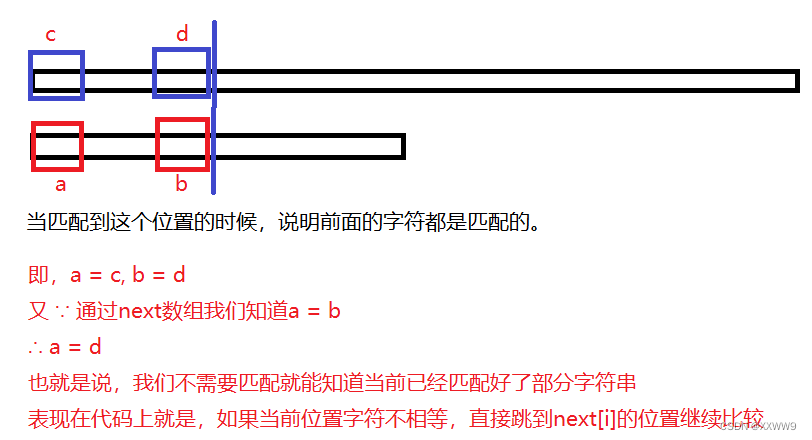
如何快速求 next 数组:
如果暴力地求next数组,时间复杂度还是很高的——
O
(
N
2
)
O(N^2)
O(N2)。
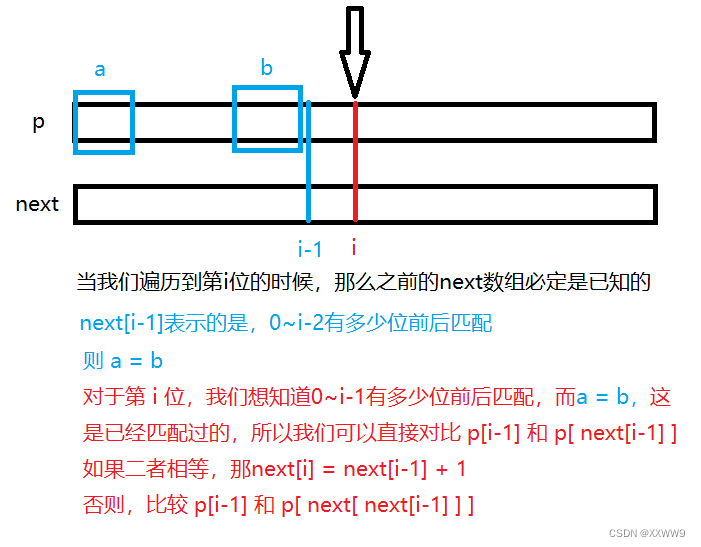
代码中是输出所有的匹配字符串,这和 找到一个匹配的就break有略微不同。
只要区别在:
1、求模式串p 的next数组时,多求一次,把next[ p.size() ] 也求出来,表示整个串 p 的最大前后匹配长度。
2、见程序kmp函数while循环的最后一行。如果 j == p.size(), 说明已经匹配完了,push结果,同时,我们就可以通过
next[ p.size() ]来快速定位到待匹配字符。
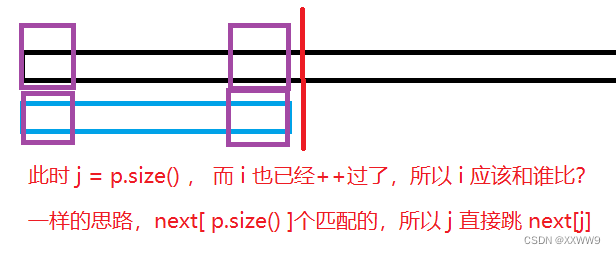
#include <iostream>
#include <vector>
using namespace std;
const int N = 1e5+10;
int nxt[N];
void getNxt(string & patten){
nxt[0] = -1, nxt[1] = 0;
int preIdx = 0, i = 2;
while( i <= patten.size()){
if(patten[preIdx] == patten[i-1]) nxt[i++] = ++preIdx;
else if(preIdx != 0) preIdx = nxt[preIdx];
else nxt[i++] = 0;
}
}
vector<int> kmp(string & str, string & patten){
vector<int> res;
int i = 0, j = 0;
getNxt(patten);
while( i < str.size()){
if(str[i] == patten[j]) ++i, ++j;
else if(j == 0) ++i;
else j = nxt[j];
if(j == patten.size()) res.push_back(i-patten.size()) , j = nxt[j];
}
return res;
}
int main(){
string a,b;
int tp;
cin >> tp >> a >> tp >> b;
vector<int> idxs = kmp(b, a);
for(auto x : idxs){
cout<< x << ' ';
}
cout << endl;
}
Trie树 / 前缀树
这个的思路我是按照牛客算法班的思路来写的。 没有考虑内存的释放问题,只开new数组,不管释放。
并且,如果把Trie树封装成一个类,会增加运算时间,所以这里用数组来模拟Trie树类的操作。
首先是,,一个index[N][26]数组来存所有的Trie树节点,同时里面的值是下一个位置的行索引。
一个pass[N][26]数组来存储经过节点的次数, 一个end[N][26]数组来存储终止于节点的次数。
在插入到某个字母的时候,如果当前没有,就把新节点放在index的len位置,同时该节点的idx指向len位置。
#include <iostream>
using namespace std;
const int N = 1e5;
int idx[N][27], pass[N][27], ed[N][27], len;
void insert(const string & s){
int slen = s.size(), row = 0;
for(int i = 0; i != slen; ++ i){
if(idx[row][s[i]-'0'] == 0) idx[row][s[i]-'0']=++len;
pass[row][s[i]-'0'] ++;
if(i == slen-1) ed[row][s[i]-'0']++;
row = idx[row][s[i]-'0'];
}
}
int query(const string & s){
int res = 0;
int slen = s.size(), row = 0;
for(int i = 0; i != slen; ++ i){
if(idx[row][s[i]-'0'] == 0) return res;
if(i == slen-1) res = ed[row][s[i]-'0'];
row = idx[row][s[i]-'0'];
}
return res;
}
int main(){
len = 0;
int t; cin >> t; cin.get();
for(int i = 0 ; i < t ; ++ i){
char ord = cin.get();
string s; cin >> s; cin.get();
if(ord == 'Q'){
cout<< query(s) << endl;
}
else{
insert(s);
}
}
}
Trie树的应用 最大异或对

这样的问题可以被抽象成 Trie树问题。
将一个数表示成二进制的形式,那么第 i 位的值就只有两种情况:0 和 1
所以这可以看成idx[N][2] 的Trie树。
首先把所有的数都插入到Trie树中。
然后再依次遍历,因为找的是最大异或对,那么如果Trie树种存在 和 自己每一位的 非 都相同的数,则和这个数异或后就能得到全1的数字,也就最大了。所以我们的查询目标就是找自己的反码。
如果某一位没有找到自己的反码,如 自己的是1,但是没找到0,那就退而求其次,这一位用1代替。
#include <iostream>
using namespace std;
const int N = 1e5+10;
int dd[N], nxt[31*N][2];
int idx;
void insert(int aa){
int p = 0;
for(int i = 30; i >=0 ; -- i){
int & target = nxt[p][(aa>>i) & 1];
if(target == 0) target = ++idx;
p = target;
}
}
int query(int x){
//输入是x,但找的是x的反码
int res = 0, p = 0;
for(int i = 30; i >=0 ; -- i){
int & target = nxt[p][!((x>>i) & 1)];
if(target != 0){
res+=(1<<i);
p = target;
}
else p = nxt[p][(x>>i) & 1];
}
return res;
}
int main(){
int n; cin >> n;
idx = 0;
for(int i = 0 ; i < n ; ++ i) {
cin >> dd[i];
insert(dd[i]);
}
int res = 0;
for(int i = 0 ; i < n ; ++ i){
res = max(res, query(dd[i]));
}
cout<< res ;
}
并查集
数组方式实现的并查集,带有优化。
通过父节点来表示其所属的组,如果父节点仍有父节点,则节点所属的组应是递归的父节点,若父节点就是本身,则组的编号就是本身。
首先,一个数组fa[N]标记当前节点的父节点是谁,然后一个num[N]数组来表示以 i 为编号的组内有多少个成员。(成员对应的num[i]为0)。最初时,fa[N]中每个点都指向自己,同时num中都是1。
然后合并某些节点时,将某个组的组号的父指向另外一个节点,同时将num相加, 就能实现合并。
#include <iostream>
using namespace std;
const int N = 1e5+10;
int fa[N], num[N];
void init(){
int n; cin >> n;
for(int i = 1 ; i <= n ; ++ i){
fa[i] = i;
num[i] = 1;
}
}
int findfa(int x){
// 递归查询,这样就能实现对fa数组的优化,避免链状查询过久的情况
if(fa[x] != x) fa[x] = findfa(fa[x]);
return fa[x];
}
bool sameset(int a, int b){
return findfa(a) == findfa(b);
}
void uniontwo(int a,int b){
int ffa = findfa(a), ffb = findfa(b);
if(ffa == ffb) return;
num[ffa] += num[ffb];
num[ffb] = 0;
fa[ffb] = ffa;
}
int getnum(int x){
return num[findfa(x)];
}
int main(){
init();
int m; cin >> m; cin.get();
while(m--){
string ope;int x, y;
cin>>ope;
if(ope == "C"){
cin >> x >> y; cin.get();
uniontwo(x, y);
}
else if(ope == "Q1"){
cin >> x >> y; cin.get();
cout<< ( sameset(x, y)?"Yes":"No" ) << endl;
}
else{
cin >> x; cin.get();
cout<< getnum(x) << endl;
}
}
}
模拟堆
用数组模拟小根堆,堆中一个节点(从1开始存储,0位置不存数据)的父节点是 x / 2 ,左子树为 x * 2 ,右子树为 x * 2 + 1。
up(int x)函数:将第x位置的值向上传递。
当没有越界 且 当前位置的值比父节点小的时候,交换当前节点和父节点的值,然后 当前节点 = 父节点。
down(int x)函数:将x位置的值向下传递。
首先,最子树根 = 当前节点
第一次:当没有越界 且 最小子树的值比左子树大的时候,最小子树= 左子树。
第二次:当没有越界 且 最小子树的值比右子树大的时候,最小子树 = 右子树。
如果最小子树更新了(即,最小子树 ≠ 当前节点) 交换位置,递归到最小子树。
heapfy函数:将整个堆进行排序,使之成为小根堆
从下往上,从len/2的位置开始down( i ),因为叶子节点不需要down
/* 堆排序的算法 */
#include <iostream>
using namespace std;
const int N = 1e5+10;
int hp[N], len;
void up(int idx){
int cur = idx, par = (cur-1)/2;
while(cur>0 && hp[cur] < hp[par]){
swap(hp[cur],hp[par]);
cur = par;
par = (cur-1)/2;
}
}
void down(int idx){
int cur = idx, chd = cur;
if(2*cur+1 < len && hp[cur] > hp[2*cur+1]) chd = 2*cur+1;
if(2*cur+2 < len && hp[chd] > hp[2*cur+2]) chd = 2*cur+2;
while(cur != chd){
swap(hp[cur], hp[chd]);
cur = chd;
if(2*cur+1 < len && hp[cur] > hp[2*cur+1]) chd = 2*cur+1;
if(2*cur+2 < len && hp[chd] > hp[2*cur+2]) chd = 2*cur+2;
}
}
int main(){
len = 0;
int n,m ; cin >> n >> m;
for(int i = 0; i < n ; ++ i){
cin >> hp[i];
len++;
}
for(int i = len/2; i>=0 ; --i) down(i);
for(int i = 0 ; i < m ; ++i){
cout<< hp[0] << ' ';
hp[0] = hp[--len];
down(0);
}
}
一个考脑筋急转弯,索引转换的题。
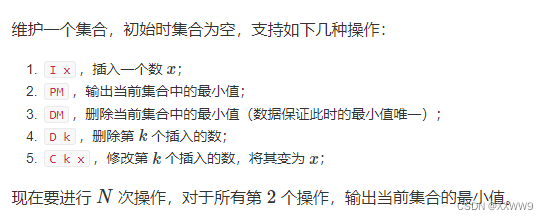
这个题比较难理解的是,怎么去映射 输入的顺序 —— 排序后的顺序
这里是用了两个数组 heap2order[] 和 order2heap[] 来存储 堆 -> 输入 和 输入 -> 堆的映射
在heap_swap(int x , int y)函数中,要想交换堆中的 x 位置 和 y 位置的两个数据,如图所示
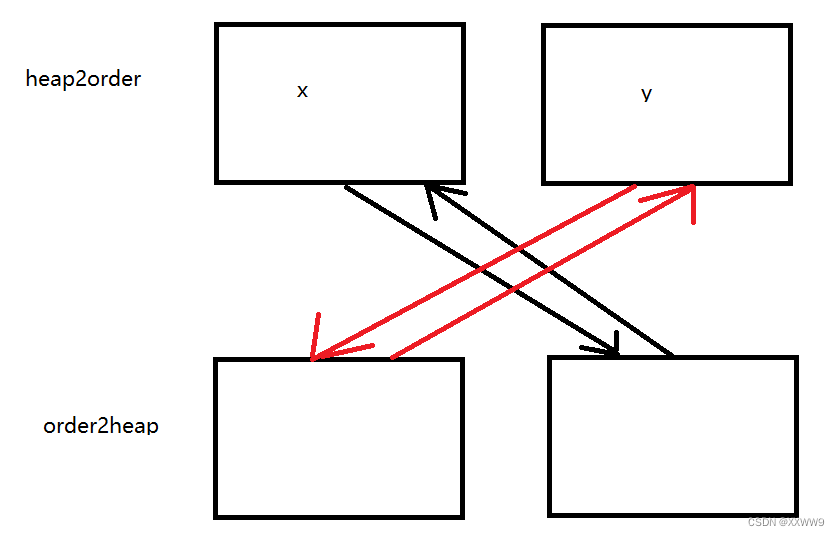
我们已知的是,x 和 y 那么我们不怕丢失的就是指向 x 和 指向 y 的索引。
所以,我们应该先交换 swap(order2heap[heap2order[x]] , order2heap[heap2order[y]] )
然后再交换 swap( heap2order[ x ] , heap2order[ y ] ) 。
然后交换heap中的值。(值的交换顺序无所谓)
#include <iostream>
using namespace std;
const int N = 1e5+10;
int heap[N], heap2order[N], order2heap[N];
int heapSize, insertTime;
void heap_Swap(int a, int b){
// 交换heap中 a , b 索引的值
swap(heap[a], heap[b]);
swap(order2heap[heap2order[a]] , order2heap[heap2order[b]]);
swap( heap2order[a], heap2order[b] );
}
void up(int x){
int par = x/2;
while(x != 1 && heap[x] < heap[par]){
heap_Swap(x,par);
x = par; par = x/2;
}
}
void down(int x){
int chd = x;
if(2*x <= heapSize) chd = heap[2*x]<heap[x]?2*x:chd;
if(2*x+1 <= heapSize) chd = heap[2*x+1]<heap[chd]?2*x+1:chd;
while(chd != x){
heap_Swap(x,chd);
x = chd;
if(2*x <= heapSize) chd = heap[2*x]<heap[x]?2*x:chd;
if(2*x+1 <= heapSize) chd = heap[2*x+1]<heap[chd]?2*x+1:chd;
// down(chd);
}
}
int main(){
heapSize = 0, insertTime = 0;
int n; cin >> n;
while(n--){
string ope; cin >> ope;
if(ope == "I"){
int x; cin >> x;
++heapSize; ++insertTime;
heap[heapSize] = x;
order2heap[insertTime] = heapSize;
heap2order[heapSize] = insertTime;
up(heapSize);
}
else if(ope == "PM"){
cout<<heap[1]<<endl;
}else if(ope == "DM"){
heap_Swap(1,heapSize);
heapSize--;
down(1);
}
else if(ope == "D"){
int x; cin >> x;
x = order2heap[x];
heap_Swap(x,heapSize);
heapSize--;
up(x);
down(x);
}else{
int x, val; cin >> x >> val;
x = order2heap[x];
//heap_Swap(x,heapSize);
heap[x] = val;
up(x);
down(x);
}
}
return 0;
}
模拟散列表(Hash)
数组哈希
1、开放寻址法
首先确定 hash函数,即把数值映射到一个hash表中的某个索引。
如果定义哈希函数为1e5+3,则应设置哈希表大小为 2*1e5+3,保证数据能存下来。
然后,将哈希表中的值进行初始化为0x3f3f3f3f,来表示这个位置有没有存储数据。
开放寻址法就是,如果求出的位置有数据在了,就向下一个位置放,如果还有数据,就接着往下找,如果到末尾了,就重新回到0,形成一个循环数组,直到放下。
因为输入的数字有可能是小于0的负数,所以需要 (X%MOD + MOD) % MOD。
#include <iostream>
#include <cstring>
using namespace std;
// 开放寻址法
const int N = 2*1e5+10, null = 0x3f3f3f3f;
const int MOD = 100003;
int hasharr[ N ];
int hashfunc(int x){
return ( x % MOD + MOD)%MOD;
}
void insert(int x){
int idx = hashfunc(x);
while(hasharr[idx] != null){
++idx;
if(idx == N) idx = 0;// 必须形成循环数组
}
hasharr[ idx ] = x;
}
bool query(int x){
int idx = hashfunc(x);
while(hasharr[idx] != x && hasharr[idx]!= null) {
++idx;
if(idx == N) idx = 0;
}
if(hasharr[idx] == x) return 1;
return 0;
}
int main(){
memset(hasharr,0x3f,sizeof hasharr);
int n; cin >> n; cin.get();
while(n--){
string ope ;
int x;
cin >> ope;
// cout<< ope << endl;
if(ope == "I"){
cin >> x;
insert(x);
}
else{
cin >> x;
cout<< (query(x)?"Yes":"No") << endl;
}
}
}
2、拉链法
拉链法 用一个hasharr来存储每个位置的链表头,每个位置是一个链表,哈希出来是这个位置的值都被挂在这个链上,
然后用一个val[] 和一个 nxt[] 数组来存储 哈希的值 和下一个位置的索引。
#include <iostream>
#include <cstring>
using namespace std;
// 拉链法
const int N = 1e5 + 10, MOD = 1e5, null = 0x3f3f3f3f;
int hasharr[N];
int len, val[N], nxt[N];
int hashfunc(int x){
return (x % MOD + MOD) % MOD;
}
void insert(int x){
int idx = hashfunc(x);
// 头插法,直接插在head
val[++len] = x;
nxt[len] = hasharr[idx];
hasharr[idx] = len;
}
bool query(int x){
int idx = hashfunc(x);
int cur = hasharr[idx];
while(cur != -1 && val[cur]!=x) cur = nxt[cur];
if(cur == -1) return 0;
return 1;
}
int main(){
len = 1;
memset(hasharr, -1 , sizeof hasharr);
int n; cin >> n;
while(n--){
string ope; cin >> ope;
int x; cin >> x;
if(ope == "I") insert(x);
else cout<< (query(x)?"Yes":"No") << endl;
}
}
字符串哈希
字符串哈希用一个p值,Q值 以及 字符的ASCII码来表示一个字符串。
首先是一个unsigned long long 数组 h[] 来存储每个的结果
然后从字符串的第0位开始,h[]需要从第一位开始,h[ i ] = (h[ i - 1 ] *p + s[ i - 1 ])% Q
这样就相当于搞了一个字符串的前缀数组。
当我们需要查找某个位置 L ~ R 的字符串时,因为L之前可能有字符,记为h[L-1],则如果想把L ~ R当成从0开始的字符串,应该去掉h[L-1]的干扰,公式为:h[R] - h[L-1]*
p
R
−
L
+
1
p^{R-L+1}
pR−L+1 % Q,这样得到的结果就是L ~ R 子串的哈希编码了。
如果两个子串的哈希编码相同,则子串就相同。(当p取131、13331的时候,Q取
2
64
2^{64}
264的时候,冲突的概率极小,而unsigned long long 刚好能对较大的数进行截断,就相当于对Q取模了。
#include <iostream>
using namespace std;
const int N = 1e5+10;
int p = 131;
unsigned long long h[N],pows[N];
string s;
unsigned long long getHash(int ll, int rr){
unsigned long long res = 0;
res = h[rr] - h[ll-1]*pows[rr-ll+1];
return res;
}
int main(){
int n, m; cin >> n >> m;
cin >> s;
pows[0]=1;
for(int i = 1; i <= n; ++ i){
pows[i] = pows[i-1]*p;
h[i] = h[i-1]*p + s[i-1];
}
while(m--){
int ll, rr, lll, rrr; cin >> ll >> rr >> lll >> rrr;
if(getHash(ll,rr) == getHash(lll,rrr)){
cout<<"Yes"<<endl;
}
else{
cout<<"No"<<endl;
}
}
}






















 被折叠的 条评论
为什么被折叠?
被折叠的 条评论
为什么被折叠?








